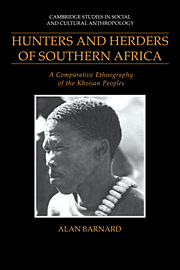Book contents
- Frontmatter
- Contents
- List of figures and maps
- List of tables
- Preface
- A note on orthography
- Part I The Khoisan peoples
- Part II A survey of Khoisan ethnography
- Part III Comparisons and transformations
- 12 Settlement and territoriality among the desert-dwelling Bushmen
- 13 Politics and exchange in Khoisan society
- 14 Aspects of Khoisan religious ideology
- 15 Bushman kinship: correspondences and differences
- 16 Khoe kinship: underlying structures and transformations
- 17 Conclusions
- References
- Index
- Cambridge Studies in Social and Cultural Anthropology
14 - Aspects of Khoisan religious ideology
Published online by Cambridge University Press: 05 June 2012
- Frontmatter
- Contents
- List of figures and maps
- List of tables
- Preface
- A note on orthography
- Part I The Khoisan peoples
- Part II A survey of Khoisan ethnography
- Part III Comparisons and transformations
- 12 Settlement and territoriality among the desert-dwelling Bushmen
- 13 Politics and exchange in Khoisan society
- 14 Aspects of Khoisan religious ideology
- 15 Bushman kinship: correspondences and differences
- 16 Khoe kinship: underlying structures and transformations
- 17 Conclusions
- References
- Index
- Cambridge Studies in Social and Cultural Anthropology
Summary
Introduction
A clue to the way to approach Khoisan religious ideology comes in a classic account of North American Indian blood sacrifice. In his paper on the origin of the Skidi Pawnee sacrifice, Ralph Linton (1926: 455–60) looked not merely to individual Skidi ideas and ritual practices, some of which were known to be of non-Pawnee origin, but to what he called the ‘underlying concepts’ of the ceremony. Commenting on the similarity between Skidi and Aztec blood sacrifices, he noted: ‘The traits themselves probably had the same origin in both cases, but their combination was, in each instance, an independent local development’ (1926: 465).
Another clue is found closer to home. Depicted on the cover of four volumes of the ‘Bushman and Hottentot Linguistic Studies’ series (e.g., Traill 1975) is a rock painting, said to be from a site called Swallewkranz. The painting shows three running figures. Two are quite ordinary male figures, but the third is peculiar. It has one body and two arms, but ten heads, and eight legs. Jeffrey Gruber (1975: 48) offers an explanation. The ‘ungrammatical’ figure might well represent an ungrammatical sentence, which in English might come out something like: ‘The people runs [sic]. While it is doubtful if the Swallewkranz figure was actually intended as part of a grammar lesson, it is intriguing to reflect on the ways in which the ‘grammar’ of Bushman thought can be manipulated, whether through language, rock art, ritual, mythology, or theology.
- Type
- Chapter
- Information
- Hunters and Herders of Southern AfricaA Comparative Ethnography of the Khoisan Peoples, pp. 251 - 264Publisher: Cambridge University PressPrint publication year: 1992



